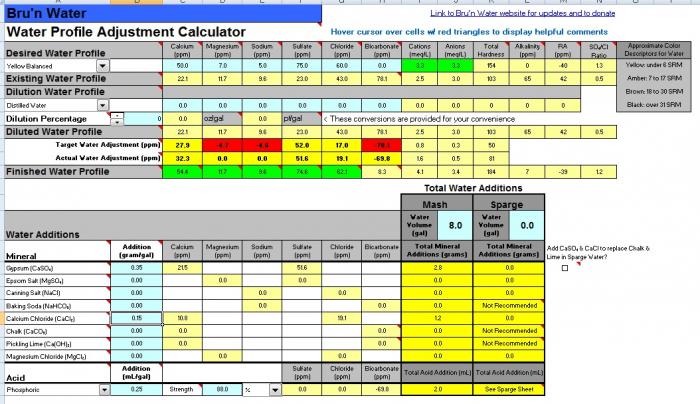roblanderson
Well-Known Member
- Joined
- Mar 17, 2013
- Messages
- 49
- Reaction score
- 3
I've done a few all-grain brews and I'd like to figure out what water adjustments might improve my beer.
This is from the 2012 report (http://www.cityblm.org/Modules/ShowDocument.aspx?documentid=5294):
__________________________________ Min-Max _______ Average
Total Alkalinity (as CaCO3) / (ppm) ______ 39-128 ________ 65
Total Hardness (as CaCO3) / (ppm) ______ 70-149 ________ 103
Calcium Hardness (as CaCO3) / (ppm) ____ 21-89 _________ 55
Magnesium Hardness (as CaCO3) / (ppm) _ 35-63 _________ 48
pH / (units) _________________________ 8.4-9.3 ________ 9.0
Sodium (highest detected level): 9.6 ppm
I called the water department and asked for cholride and sulfate:
Chloride: 43 mg/L
Sulfate: 23 mg/L
From these numbers do I have everything I need? Do I need to do any conversions before plugging these numbers into BeerSmith or other water calculators like Bru n Water?
I'd appreciate any help! We brew a wide range of beers, pale ales to dark stouts. Going to try our first lager soon as well.
This is from the 2012 report (http://www.cityblm.org/Modules/ShowDocument.aspx?documentid=5294):
__________________________________ Min-Max _______ Average
Total Alkalinity (as CaCO3) / (ppm) ______ 39-128 ________ 65
Total Hardness (as CaCO3) / (ppm) ______ 70-149 ________ 103
Calcium Hardness (as CaCO3) / (ppm) ____ 21-89 _________ 55
Magnesium Hardness (as CaCO3) / (ppm) _ 35-63 _________ 48
pH / (units) _________________________ 8.4-9.3 ________ 9.0
Sodium (highest detected level): 9.6 ppm
I called the water department and asked for cholride and sulfate:
Chloride: 43 mg/L
Sulfate: 23 mg/L
From these numbers do I have everything I need? Do I need to do any conversions before plugging these numbers into BeerSmith or other water calculators like Bru n Water?
I'd appreciate any help! We brew a wide range of beers, pale ales to dark stouts. Going to try our first lager soon as well.




